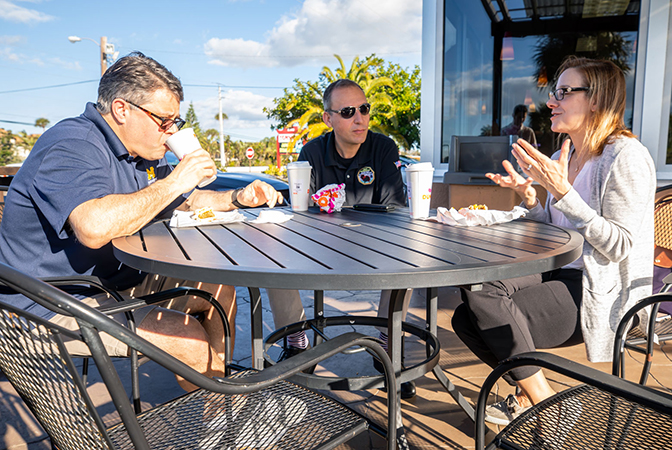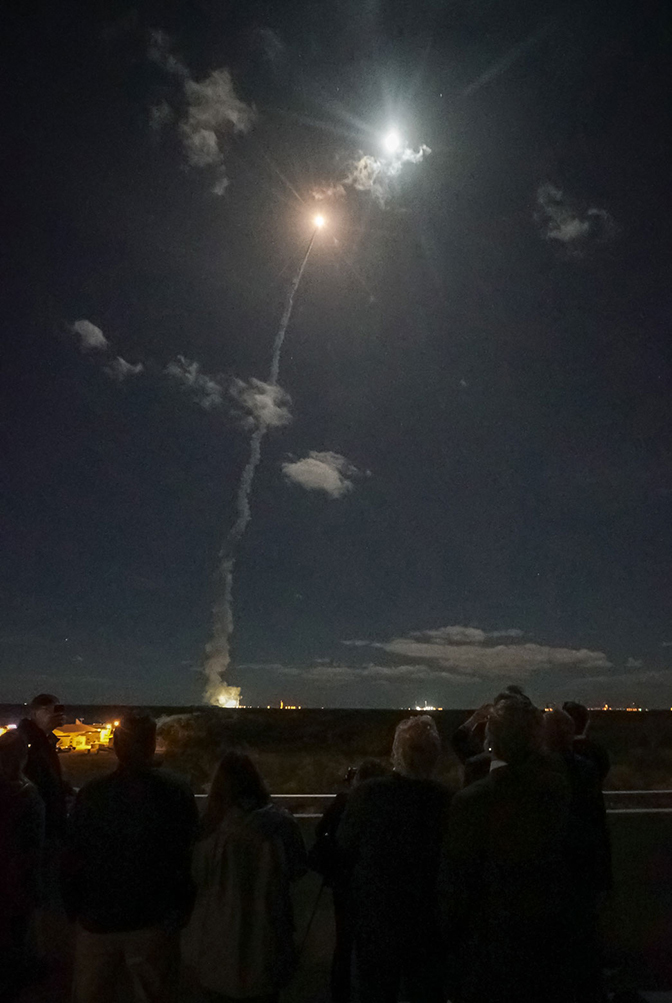Launching Solar Orbiter
For more than a decade, a U-M team helped develop the scientific payload aboard Solar Orbiter. Join them on launch night.
For more than a decade, a U-M team helped develop the scientific payload aboard Solar Orbiter. Join them on launch night.
On the night of February 9, 2020, an international family of collaborators passes through Kennedy Space Center’s security entrance. Busses deliver eager passengers through restricted areas to special viewing locations. In the distance, the stage is set at Space Launch Complex 41. The audience anxiously anticipates the countdown clock and roaring spectacle it triggers.
For colleagues Sue Lepri and Jim Raines, this moment has been 13 years in the making. “It’s a very long time to work on a project, more than a solar cycle, and so it’s amazing to be here – it’s just blowing my mind really,” says Lepri, professor of Climate & Space Sciences and Engineering.
Waiting on the launch pad atop an United Launch Alliance Atlas V rocket is Solar Orbiter (SolO), a satellite packed with an unprecedented suite of technology to study the sun. One of its instruments is a critical sensor that analyzes the composition of heavy ions in the solar wind. Lepri and Raines have been leading its development and are responsible for analyzing the science it will collect on its journey.
For Sarah Spitzer, Lepri’s PhD candidate, the moment is a culmination of emotions. “I actually didn’t realize how much it would mean to me to be here with my colleagues, with my advisors,” says Spitzer. “It’s just so cool to be at a place that was so awe-inspiring when I was a little kid. And to think I’m not a tourist right now – I’m one of the scientists that makes this happen.”
The anticipation of this launch has been amplified by a series of delays. “We were supposed to launch in 2017, and there were some issues and so it was delayed to 2018, and then 2019 – and now we’re here,” says Lepri.” Yet even tonight’s launch window has been elusive. Originally slated for February 5, it has slipped twice on the way to its current, delicate standing. For the team — their dreams, aspirations and travel plans are at the mercy of tonight’s fortune.
For Sue and her family in tow, it’s been a day-of scramble. “I booked my travel plans a while ago when the launch was supposed to be on February 5th,” explains Lepri. “I had to call and change my flights today, and was sitting in a hotel lobby – checking if they had any rooms. The kids were sleeping in the lobby. It’s been nuts.”
“The first thing I’m looking forward to is it launching safely – that’s the honest truth,” admits Raines, associate research scientist in U-M’s Climate and Space Sciences and Engineering department. “I have every reason to believe that it will, but I think several of us are just holding our breath a little bit, making sure that it does.”
Uncertainty is an agonizing component of space launches, but 2020 is certainly ushering in a shiny new era for solar science. A fleet of spacecraft is already out there looking at the sun. “There’s several of them sitting at the gravitational balance point between the sun and the Earth called L1, the first Lagrangian point,” explains Lepri. “Then we have a lot of instruments near Earth that are measuring the impact of the solar wind on the Earth’s magnetosphere. Solar Orbiter and Parker Solar Probe are really providing our closest views of the sun.”
NASA’s Parker Solar Probe launched in 2018 and also carries U-M expertise with it. Lepri’s colleague, Justin Kasper, is a professor of climate and space sciences and engineering at U-M and a principal investigator for the Parker mission – which measures the solar wind at extreme proximity to the sun. The first data from Parker’s historic look inside the sun’s corona was published in late 2019 – stunning the solar science community with unanticipated results and descriptions of rogue plasma waves.
SolO is a separate but complementary mission, led by the European Space Agency (ESA) with close partnership from NASA. SolO’s bigger body (roughly the size of a Chevy Tahoe) is packed with an array of 10 primary instruments, one of which Lepri is the deputy principal investigator for. Parker (think Chevy Malibu) carries four instrument suites. It needed to be a lot lighter for its orbit to dip so close to the sun. Furthermore, Parker can’t carry the same kind of hardware because of the extreme heat. For example, unlike SolO, Parker has no cameras that view the sun directly. Technology isn’t yet capable of surviving a stare-down with the sun from that close up.
Where Parker collects ground-zero samples, SolO is further back and able to use its cameras in conjunction with other onboard sensors to localize its solar wind samples to where they originated on the sun. And at key moments, both satellites’ orbits align so that they can do measurements on the same gusts of solar wind at different points downstream.
Especially exciting is that SolO will provide new observations of the sun’s mysterious poles. Better understanding the magnetic polar flips that influence solar cycles and space weather is a key mission objective.
“Let’s say that I have a candle and I blow it out and there’s soot trailing off of it,” explains Lepri. “As you get further from the candle, that soot kind of dissipates and you can’t really tell where it is anymore. That’s what happens as the sun blows out the solar wind – it spreads out and it starts to get muddied.”
The goal behind Parker and SolO’s tag-team approach to analyzing the solar wind is to better predict when space “soot” might be a threat. A lot of the things that we take for granted, like our ability to use cell phones, have electricity, have GPS navigation – all of those things actually rely on our understanding of the space environment around the Earth.
“We live on planet Earth…in space,” says Spitzer. “Everything here, life on this planet, is affected by the near space environment. If you lived on a small island in the middle of the ocean, you probably would want to know something about the ocean. You would probably want to know if there were tsunamis or hurricanes, or other environmental factors that could affect your life.”
Our ability to predict space weather is also important as humans spend more time in space.
“I mean, the idea of sending humans to Mars, for example, one of the big things that’s holding us back is we don’t have any way to predict the space weather environment,” says Raines. “Some of the aspects of space weather are these high-energy particles that, unless it’s substantially thick, can basically penetrate right through metal shielding and damage people in the same way that x-rays can.”
Over the years, many U-M Climate and Space students and faculty have contributed to the development of SolO’s Heavy Ion Sensor. Lepri and Raines have always been there – helping design the original proposal back in 2007. At that time, their advisor was Thomas Zurbuchen, the current Associate Administrator for the Science Mission Directorate at NASA. Although responsible for an array of other NASA projects, the U-M team and SolO are still close to his heart – and on launch day, he happened to be close by.
Planning to attend the launch in official NASA capacity, Zurbuchen was able to connect with his former students. A text on the morning-of included the address to a Dunkin’ Donuts along the main drag down Cocoa Beach. The three friends enjoyed a coffee in the early Florida sun.

“I was really proud of the team,” recalls Zurbuchen. “We were a really strong team because we came off the work from Mercury Messenger. We knew each other, yet we were diverse in the way we thought – the way we worked. We tried really hard to bring other dimensions of diversity to bear, and that makes the teams better. I use that every day at NASA, what I learned at Michigan during these kinds of projects – Messenger and the activity for this one.”
In addition to talking about the team dynamics, they discuss the Heavy Ion Sensor. “My expectation would be that this instrument will be in the news many times, because of the novelty of its measurement,” says Zurbuchen. “This one is really different. There are probably three or four of the 10 (aboard SolO) that have fundamentally new attributes, this one is one of them.”
Back at Kennedy, everything looks clear for launch and the vibe is palpable.
“Throughout the whole mission, we’ve been surrounded by a great team that extends beyond Michigan: the University of New Hampshire, our colleagues at Southwest Research in San Antonio and our European colleagues,” says Lepri. “It’s more of a family than it is a team. Here we all are – we brought our families, and we’re just all together to enjoy this. It’s amazing to be here with my old advisor and with Sarah. It’s an experience that, as a grad student, I would’ve been just floored by.”
After a final mission briefing, the countdown clock approaches its final minutes. Zurbuchen, Lepri and Raines find each other on the balcony of Operations Support Building II – this time with Spitzer. Two generations of advisors and their students stand together, ready to share an incredible view and accomplishment. “We are clear to launch,” a voice commands through the PA system. Checking her smartwatch, “What’s my heart rate, what’s my heart rate,” repeats Lepri. “Remember to breathe,” she reminds herself.

When the clock reaches 10, as if by involuntary command, every voice begins counting down. Three. Two. One. The rocket ignition flips a dawn-like switch over a 4-mile radius, illuminating the exuberant expressions of the U-M team. Applause and cheers are quickly drowned as the sound wave catches up. There’s a violent beauty to the levitating inferno and crackling roar. Climbing through the clear night sky, the cheers relax into awe. Time slows down. With no clouds blocking the ascent, the rocket’s full sequence plays out in clear view: the pitchover maneuver, throttling down into Max Q (maximum dynamic pressure) and the booster jettison.
All eyes are fixed on the fading rocket, except for Zurbuchen. For a moment he turns to watch the faces of his former students.
“It’s just unbelievable,” says Lepri, catching her breath. “It was so amazing, I can’t find the words to describe it. It’s not like we made 20 of them. There’s one, and it better go right and work when it’s up there. It was terrifying.”
The team lingers on the balcony until the last flicker blinks out of sight. Inside the scientists share a celebratory champagne toast.
There is more joy, fear and collaboration in store as SolO journeys toward the sun. Now it’s a space mission. In the coming weeks, each instrument will take turns coming online. Data will begin to pour in – with the first public data anticipated for September 2020.
Each gravity assist and wave of discovery will bring butterflies to the U-M team and the global SolO family. Launch is just the beginning.